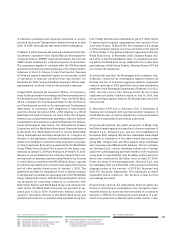Siemens 2010 Annual Report Download - page 283
Download and view the complete annual report
Please find page 283 of the 2010 Siemens annual report below. You can navigate through the pages in the report by either clicking on the pages listed below, or by using the keyword search tool below to find specific information within the annual report.
147 Consolidated Financial Statements
148 Consolidated Statements of Income
149 Consolidated Statements of Comprehensive Income
150 Consolidated Statements of Financial Position
151 Consolidated Statements of Cash Flow
152 Consolidated Statements of Changes in Equity
154 Notes to Consolidated Financial Statements
(in millions of €, except where otherwise stated
and per share amounts)
261 Additional information
– Derivative financial instruments
and hedging activities
As part of the Company ’s risk management program, a variety
of derivative financial instruments are used to reduce risks
resulting primarily from fluctuations in foreign currency ex-
change rates, interest rates and commodity prices, as well as
to reduce credit risks. For additional information on the Com-
pany ’s risk management strategies, including the use of de-
rivative financial instruments to mitigate or eliminate certain
of these risks, see also Note .
The fair values of each type of derivative financial instruments
are as follows:
September , September ,
Asset Liability Asset Liability
Foreign currency
exchange contracts 858 423 735 462
Interest rate swaps
and combined interest /
currency swaps 2,317 416 1,764 204
Commodity swaps 78 11 43 23
Embedded derivatives 96 100 156 133
Options 289 308 170 172
Other 4 4 3 4
3,642 1,262 2,871 998
Foreign currency exchange risk management
As described in Note , the Company employs various deriva-
tive financial instruments in order to mitigate or eliminate
certain foreign-currency exchange risks.
Derivative financial instruments not designated
in a hedging relationship
The Company manages its risks associated with fluctuations in
foreign-currency-denominated receivables, payables, debt,
firm commitments and anticipated transactions primarily
through a Company-wide portfolio approach. This approach
concentrates the associated Company-wide risks centrally, and
various derivative financial instruments, primarily foreign cur-
rency exchange contracts and options, are utilized to minimize
such risks. Such a strategy does not qualify for hedge account-
ing treatment under IAS , Financial Instruments: Recogni-
tion and Measurement. Accordingly, all such derivative finan-
cial instruments are recorded at fair value on the Consolidated
Statements of Financial Position, either as Other current finan-
cial assets / liabilities or Other financial assets / liabilities, and
changes in fair values are charged to net income (loss).
The Company also has foreign-currency derivative instru-
ments, which are embedded in certain sale and purchase
contracts denominated in a currency other than the functional
currency of the significant parties to the contract and other
than a currency which is commonly used in the economic en-
vironment in which the contract takes place. Gains or losses
relating to such embedded foreign-currency derivatives are
reported in Cost of goods sold and services rendered in the
Consolidated Statements of Income.
Hedging activities
The Company ’s operating units applied hedge accounting for
certain significant anticipated transactions and firm commit-
ments denominated in foreign currencies. Specifically, the
Company entered into foreign exchange contracts to reduce
the risk of variability of future cash flows resulting from fore-
casted sales and purchases and firm commitments resulting
from its business units entering into long-term contracts (proj-
ect business) and standard product business which are de-
nominated primarily in U.S. dollar.
Cash flow hedges – Changes in fair value of forward exchange
contracts that were designated as foreign-currency cash flow
hedges are recorded as follows: the portion of the fair value
changes that is determined to be an effective hedge is recog-
nized in Other comprehensive income, whereas the ineffective
portion of the fair value changes is recognized in profit or loss.
As of September , and , the ineffective portion that
was immediately recorded in profit or loss amounted to €()
and €, respectively. In fiscal and , net gains and
losses of € and €(), respectively, were reclassified from Other
comprehensive income into Cost of goods sold and services
rendered because the occurrence of the related hedged fore-
casted transaction was no longer probable. The development
of Other comprehensive income resulting from changes in fair
value of these transactions as well as from amounts that were
removed and included in profit or loss is presented in Note .
It is expected that € of net deferred gains in Other compre-
hensive income will be reclassified into Cost of goods sold and
services rendered in fiscal , when the hedged forecasted
foreign-currency denominated transaction affects profit or
loss.
























